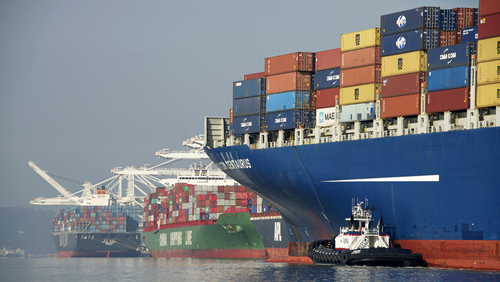That has led to growing calls by world leaders to rein in global supply lines and bring more manufacturing back to domestic markets. But the operators of the mammoth vessels that are the backbone of the trading economy aren’t banking on a retreat from globalization soon.
The owners of ships, from the hulking bulk carriers that haul iron ore and other metals to the improbably large container ships that ferry retail goods and manufacturing parts across oceans, have slimmed down their sailings in response to the global downturn. But for seagoing companies, the pandemic is a detour from entrenched strategies, not a change of course.
That is because they believe the enormous production network China has built over the past 20 years, a sprawling system of factories that churns out electronics, toys, clothing, medicine and industrial goods for the rest of the world, will remain a driving force of trade.
“China will continue to be the world’s factory because nothing else comes even close,” said Peter Sand, chief shipping analyst at industry trade body BIMCO. “They built a massive logistics ecosystem that keeps global trade ticking, and they are really good at it.”
With China’s labor costs around four times lower than those of the U.S., according to the World Bank, and its distribution channels designed to facilitate mass exports, setting up factories in the West to replace Chinese goods or make up for temporary production lapses would be a daunting proposition.
China’s maritime infrastructure on its own would be all but impossible to duplicate in Western countries,
China boasts seven of the world’s 10 biggest ports, including that of Shanghai. The runaway leader in terms of volumes, the Port of Shanghai handles nearly three times more containers every year than the top U.S. gateway at the neighboring ports of Los Angeles and Long Beach combined.
Shipping companies have adapted to the China volumes by deploying a special class of container ships that are as long as three football fields and that can each move 23,000 containers.
These vessels are shared even among rival operators to move cargo and make port calls, cutting the cost of moving boxes by about a third from that of the earlier class of big ships, provided they are full.
Cratering demand from the Covid-19 lockdowns has left many of those ships sailing half empty or shuffled into storage. But operators aren’t looking to replace them with anything smaller.
“There are some factories for medicine, medical equipment and masks that are based only in China,” said a spokesman for German liner Hapag-Lloyd AG . “That might change if companies feel that they are dependent on a single location, but globalization will by no means be withdrawn and neither will those ships.”
Most operators see a gradual economic turnaround after the Coronavirus carnage. This means the big ships will wait for longer to fill up and make fewer port calls that could push back deliveries for scores of products.
“We don’t see a fast, V-shaped recovery,” the Hapag-Lloyd spokesman said. “We have to wait and see how the routes will recover. It will take some time, but we are expecting a good recovery in the fourth quarter.”
The top 10 container lines are looking at steep losses in the third quarter. For Hapag-Lloyd, this means postponing its order for six new ultralarge ships—to add to the six it already has—to next year.
“The industry will see the financial effects of the lockdowns from March and April in June and June and July. So the third quarter will be the most difficult,” the Hapag-Lloyd spokesman said. “But we need the big ships, because the world will reopen and volumes will pick up. That model won’t change.”
Executives at other operators said they had received many complaints about long delivery delays during the Chinese lockdown, when handling at China’s ports ground nearly to a halt. The chief operating officer of a big Asia liner said, “We brainstorm together with clients looking for possible supply-chain alternatives. But honestly I don’t think there are any.”
China’s role as a global producer and supply-chain heavyweight was reflected in an American Chamber of Commerce in China survey conducted by PricewaterhouseCoopers LLP in March. More than 70% of survey respondents said they had no plans to relocate production and supply-chain operations outside the country because of the pandemic.
“In contrast to some global narratives, our China-based data suggests that the majority of our members won’t be packing up and leaving China soon,” Alan Beebe, president of AmCham China, said in a statement.
Instead, he said, the group expects “to see companies adopting a ‘China + 1’ strategy as a way to diversify supply-chain risks while tapping into China market opportunities.”













